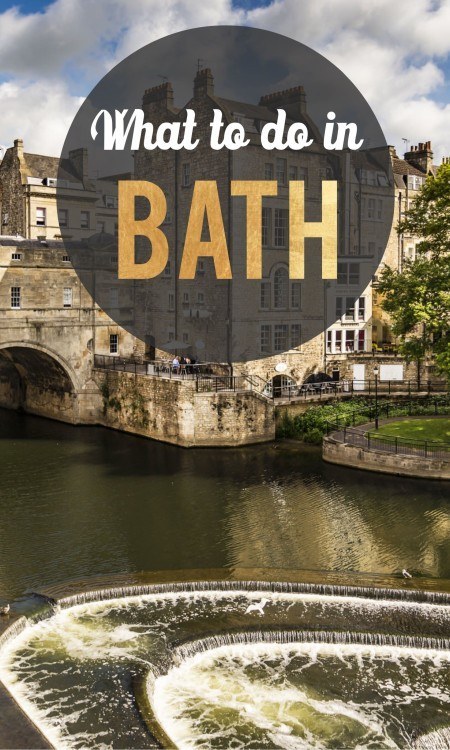Sponsored Listings:
Bath is one of the most picturesque towns in England, and its famous Roman baths (for which the town is named) draw hundreds of thousands of tourists each year. Bath is definitely worth a visit, and as it is located just 90 minutes by train from London, can be conceivably visited in a daytrip from the capital. We’d recommend an overnight stay, though, and a longer visit would allow you to truly soak up the atmosphere.
Getting there
National Express, the coach company, also runs a service to Bath from London (and from many other places throughout the country). The trip’s a lot longer than the equivalent train journey – between three and three-and-a-half hours. National Express often has cheaper fares for as low as £5 per person each way – a good discount off the standard £18.70 fare. Book in advance to get the cheapest fare.
The closest airport to Bath is Bristol airport, still a good hour away from Bath by coach and train, but worth considering over London if you’re flying in from continental Europe.
And, of course, you can hire a car and drive there if you like, giving you the flexibility to see some of the countryside and other attractions of the South West. But for Bath itself, a car isn’t necessary – the town is very compact and you can see all the principal attractions on foot.|
Attractions
So what are these principal attractions? Bath is a world heritage site, and its architecture and Roman ruins are the biggest drawcards, but the public gardens are also spectacular.
Roman Baths
Bath’s number-one attraction is conveniently located in the centre of town. Well, perhaps it is fairer to say that the town grew up around the baths, given that the Romans moved to the area to make use of the hot springs. They weren’t the first ones there – the Celts used the site as a shrine to Sulis (also known as Minerva).
It costs £15 per adult to get in, and if you buy a combined ticket you can get a discount on the Fashion Museum and the Victoria Art Gallery. The audioguide is free and informative, with explanations of the baths, Roman life, and some of the artifacts that have been found in and around the baths.
Museums
Take your pick – Bath has a Fashion Museum, a Postal Museum, a Museum of Bath at Work, a Musuem of East Asian Art, a Jane Austen musuem, and a Museum of Astronomy (among many others). Unlike museums in London, you have to pay to enter, but for many you can get a 2-for-1 entry if you travel by train.
Gardens
Bath is full of parks and gardens. Royal Victoria Park was opened by Princess Victoria when she was 11 years old – she was so impressed that she honoured it with the word “Royal”. The Parade Gardens run along the river front near the abbey, and Jane Austen used to enjoy the free Sydney Gardens. The Queen’s garden features an obelisk and is a nice place to have lunch, while the hidden gem of the Georgian garden is located at the back of a Georgian house and can be accessed from the Gravel Walk. There are a lot more to choose from – wander around and discover your favourite.
Buildings and rooms
Visit Bath Abbey – the last Gothic church in England. It’s just across the square from the baths, in fact you can get some nice photos of it from inside the bath complex. Pulteney Bridge and Pulteney Weir are both impressive, the bridge being famous for having shops all along it, like Florence’s famous bridge. Apparently only four bridges in the world share this honour. The Royal Crescent was designed by John Wood and finished in 1774, and is an excellent example of Georgian architecture – head to the Circus nearby for another one. The grass park in front of the Royal Crescent buildings features a haha, a kind of hidden fence used to keep out livestock. Also, stop into the Assembly Rooms, to see where the balls in Jane Austen‘s books were held.
Shop
Jane Austen’s characters in her novels that are set in Bath always seemed to be shopping. Most of the shops around the Roman Baths are pretty touristy, but if you roam further afield you’ll find some nice little stores. And of course, there’s a full range of supermarkets, banks, and high street shops.
Eat
Bath has a wide range of restaurants, but if you’re only here for a day, you’d be better picking up a picnic and eating outside. There’s a Waitrose right near Pultney Bridge, stop in and stock up and eat beside the river in Parade Garden.
We discovered the best coffee we’ve had in the UK at Colonna & Small’s Espresso Rooms in Princes Street. The coffee was made well and with love, and the decor in the two small rooms upstairs was pleasant. If you’re after a cream tea, you could try the Sally Lunn’s tearoom, which is located in the oldest house in Bath, and sells the famous Sally Lunn bun.
Two-for-one offers
Throughout Britain, you can get a two-for-one deal on certain attractions if you travel there by train. You need to fill in an online form, print out a voucher, and show the voucher and the train ticket when you’re buying your tickets at the attraction. Some of the things you can do in Bath on this offer include: Thermae Bath Spa, Bath Abbey, the museums of Bath at Work, East Asian Art, Post, and Fashion, as well as discounts on meals at several restaurants and coffee houses. Check out the Visit Bath website for a full list of attractions.
Bath is a great place for a visit during a stay in the UK. Whether you stay for a day or a year, you’re sure to have a great time!
Source: IndieTravelPodcast.com










